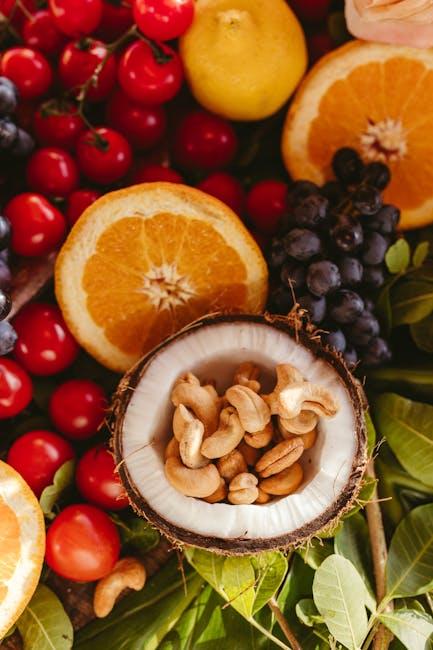Embarking on a journey toward long-term fat loss is not just about shedding pounds; it’s about embracing a healthier lifestyle that is sustainable and rewarding. The foundation of this journey is built on making informed dietary choices that fuel your body efficiently while promoting gradual, lasting weight loss. In this guide, we will explore the essential principles of selecting the best foods that support fat loss over the long haul. By understanding the nutritional value, portion control, and the role of balanced meals, you can make empowered decisions that not only enhance your well-being but also help you achieve and maintain your desired weight. Let’s delve into the strategies that will transform your eating habits and set you on the path to success.
Understanding Macronutrients and Their Role in Fat Loss
To achieve sustainable fat loss, understanding the essential macronutrients—proteins, carbohydrates, and fats—is crucial. Each plays a distinct role in your body and can significantly influence your weight loss journey. Proteins are the building blocks of muscle and can help increase metabolism by preserving lean muscle mass, which is vital for burning calories even at rest. Incorporate lean sources such as chicken, fish, and plant-based options like beans and lentils. Carbohydrates, often misunderstood, are not the enemy. Opt for complex carbs like whole grains, vegetables, and fruits that provide sustained energy and keep you satiated longer.
Fats are essential for hormone production and nutrient absorption. Choose healthy fats such as avocados, nuts, seeds, and olive oil. Balancing these macronutrients can help you create a diet that supports fat loss without feeling deprived. Consider these tips to optimize your macronutrient intake:
- Prioritize whole, unprocessed foods to ensure you get the most nutritional value.
- Adjust macronutrient ratios based on your activity level and personal goals.
- Stay hydrated and listen to your body’s hunger and fullness cues.

Identifying Foods That Boost Metabolism and Burn Fat
When it comes to boosting metabolism and burning fat, understanding which foods can make a difference is key. Certain foods have thermogenic properties, meaning they help increase your metabolic rate, allowing you to burn more calories even at rest. To make informed choices, focus on incorporating these metabolism-enhancing foods into your diet:
- Lean Proteins: Foods like chicken breast, turkey, and tofu require more energy to digest, effectively increasing calorie burn.
- Whole Grains: Opt for quinoa, oats, and brown rice, which are high in fiber and help stabilize blood sugar levels.
- Spicy Foods: Ingredients such as cayenne pepper and chili can temporarily boost metabolism through their active compound, capsaicin.
- Green Tea: Rich in catechins, green tea can enhance fat oxidation and improve overall metabolic rate.
- Fruits and Vegetables: Particularly those high in water and fiber like apples, berries, and leafy greens, help you feel full longer, reducing overall calorie intake.
By prioritizing these foods, you’re not just fueling your body efficiently but also setting the stage for sustainable, long-term fat loss.

Incorporating Whole Foods for Sustainable Weight Management
Embracing whole foods is a cornerstone of sustainable weight management, offering a pathway to not just fat loss, but also enhanced overall health. Whole foods are nutrient-dense, meaning they provide a high amount of nutrients relative to their calorie content. This ensures your body gets the essential vitamins, minerals, and fibers needed for optimal functioning without the excess calories that lead to weight gain. Opt for foods in their natural state, such as fruits, vegetables, whole grains, and lean proteins. These foods are typically lower in calories yet high in satiating nutrients, helping you feel full longer and curbing the temptation to overeat.
- Fruits and Vegetables: Rich in fiber, vitamins, and minerals, they should form the bulk of your diet.
- Whole Grains: Choose options like quinoa, brown rice, and oats that are less processed and have a lower glycemic index.
- Lean Proteins: Incorporate sources like chicken, fish, and legumes to support muscle maintenance and repair.
- Healthy Fats: Don’t shy away from avocados, nuts, and olive oil, which are essential for hormone balance and overall health.
Transitioning to a diet rich in whole foods can initially seem daunting, but with gradual changes, it becomes a rewarding lifestyle choice. Start by replacing processed snacks with fresh alternatives and choose whole-grain versions of your favorite staples. Remember, the key is consistency and making choices that align with your long-term health goals. By prioritizing whole foods, you are not just managing your weight but also investing in a healthier future.

Crafting a Balanced Meal Plan for Long-Term Success
Crafting a meal plan that supports long-term fat loss isn’t just about cutting calories; it’s about choosing nutrient-dense foods that fuel your body and keep you satisfied. To start, focus on incorporating a variety of whole foods that are rich in vitamins, minerals, and antioxidants. A balanced meal plan should include:
- Lean Proteins: Opt for sources like chicken, fish, tofu, and legumes to help build muscle and keep hunger at bay.
- Complex Carbohydrates: Choose whole grains such as quinoa, brown rice, and oats, which provide sustained energy and are high in fiber.
- Healthy Fats: Include avocados, nuts, seeds, and olive oil to support brain health and hormonal balance.
- Fresh Vegetables and Fruits: Aim for a colorful variety to ensure you’re getting a range of nutrients and to add flavor and volume to your meals.
Incorporating these elements will not only help with fat loss but also enhance your overall health and well-being. Remember, consistency is key, and by making these choices part of your daily routine, you’re setting yourself up for sustainable success.
